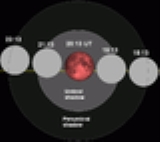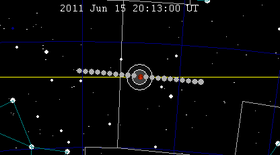
June 2011 lunar eclipse
Encyclopedia
| Total lunar eclipse June 15, 2011 |
|
|---|---|
| The eclipse as seen from Tanzania Tanzania The United Republic of Tanzania is a country in East Africa bordered by Kenya and Uganda to the north, Rwanda, Burundi, and the Democratic Republic of the Congo to the west, and Zambia, Malawi, and Mozambique to the south. The country's eastern borders lie on the Indian Ocean.Tanzania is a state... |
|
 The moon passes right to left through the Earth's shadow |
|
| Gamma Gamma (solar eclipse) Gamma of an eclipse describes how centrally the shadow of the moon or earth strikes the other. The distance, when the axis of the shadow cone passes closest to earth or moon's center, is stated as fraction of the equatorial radius of the earth... |
0.0897 |
| Duration (hr:mn:sc) | |
| Totality | 01:40:52 |
| Partial | 3:39:58 |
| Penumbral | 5:39:10 |
| Contacts (UTC) | |
| P1 | 17:23:05 |
| U1 | 18:22:37 |
| U2 | 19:22:11 |
| Greatest | 20:12:37 |
| U3 | 21:03:22 |
| U4 | 22:02:35 |
| P4 | 23:02:15 |
 The moon's hourly motion across the Earth's shadow in the constellation of Ophiuchus (north of Scorpius) |
|
A total lunar eclipse
Lunar eclipse
A lunar eclipse occurs when the Moon passes behind the Earth so that the Earth blocks the Sun's rays from striking the Moon. This can occur only when the Sun, Earth, and Moon are aligned exactly, or very closely so, with the Earth in the middle. Hence, a lunar eclipse can only occur the night of a...
took place on June 15, 2011. It was the first of two such eclipses in 2011. The second will occur on December 10, 2011
December 2011 lunar eclipse
A total lunar eclipse will take place on December 10, 2011. It will be the second of two total lunar eclipses in 2011, the first having occurred on June 15.- Visibility :...
.
This was a relatively rare central lunar eclipse, in which the center point of Earth's shadow passes across the Moon. The last time a lunar eclipse was closer to the center of the earth's shadow was on July 16, 2000
July 2000 lunar eclipse
A total lunar eclipse took place on July 16, 2000, the second of two total lunar eclipses in 2000.The moon passed through the very center of the Earth's shadow...
. The next central total lunar eclipse will be on July 27, 2018
July 2018 lunar eclipse
A total lunar eclipse will take place on July 27, 2018. The moon will pass through the center of the Earth's shadow.- Visibility :It will be completely visible over Western Africa, and Central Asia, seen rising over South America, Eastern Africa, and Europe, and setting over Eastern Asia, and...
over South America
South America
South America is a continent situated in the Western Hemisphere, mostly in the Southern Hemisphere, with a relatively small portion in the Northern Hemisphere. The continent is also considered a subcontinent of the Americas. It is bordered on the west by the Pacific Ocean and on the north and east...
, western Africa
Africa
Africa is the world's second largest and second most populous continent, after Asia. At about 30.2 million km² including adjacent islands, it covers 6% of the Earth's total surface area and 20.4% of the total land area...
, and Europe
Europe
Europe is, by convention, one of the world's seven continents. Comprising the westernmost peninsula of Eurasia, Europe is generally 'divided' from Asia to its east by the watershed divides of the Ural and Caucasus Mountains, the Ural River, the Caspian and Black Seas, and the waterways connecting...
, and setting over eastern Asia
Asia
Asia is the world's largest and most populous continent, located primarily in the eastern and northern hemispheres. It covers 8.7% of the Earth's total surface area and with approximately 3.879 billion people, it hosts 60% of the world's current human population...
. In western Asia, Australia
Australia
Australia , officially the Commonwealth of Australia, is a country in the Southern Hemisphere comprising the mainland of the Australian continent, the island of Tasmania, and numerous smaller islands in the Indian and Pacific Oceans. It is the world's sixth-largest country by total area...
and the Philippines
Philippines
The Philippines , officially known as the Republic of the Philippines , is a country in Southeast Asia in the western Pacific Ocean. To its north across the Luzon Strait lies Taiwan. West across the South China Sea sits Vietnam...
, the lunar eclipse was visible just before sunrise.
Visibility and viewing
The lunar eclipse is very visible in the clear and cloudless night sky throughout eastern and southeast Asia. Filipino amateur astronomers and eclipse watchers peered into their telescopes as the eclipse appears over Metro ManilaMetro Manila
Metropolitan Manila , the National Capital Region , or simply Metro Manila, is the metropolitan region encompassing the City of Manila and its surrounding areas in the Philippines...
and other parts of the country, and also in China
China
Chinese civilization may refer to:* China for more general discussion of the country.* Chinese culture* Greater China, the transnational community of ethnic Chinese.* History of China* Sinosphere, the area historically affected by Chinese culture...
, Japan
Japan
Japan is an island nation in East Asia. Located in the Pacific Ocean, it lies to the east of the Sea of Japan, China, North Korea, South Korea and Russia, stretching from the Sea of Okhotsk in the north to the East China Sea and Taiwan in the south...
and South Korea
South Korea
The Republic of Korea , , is a sovereign state in East Asia, located on the southern portion of the Korean Peninsula. It is neighbored by the People's Republic of China to the west, Japan to the east, North Korea to the north, and the East China Sea and Republic of China to the south...
. The eclipse is also seen over India
India
India , officially the Republic of India , is a country in South Asia. It is the seventh-largest country by geographical area, the second-most populous country with over 1.2 billion people, and the most populous democracy in the world...
, and other south and southwest Asian countries (as in the Middle East
Middle East
The Middle East is a region that encompasses Western Asia and Northern Africa. It is often used as a synonym for Near East, in opposition to Far East...
).
Africa
Africa
Africa is the world's second largest and second most populous continent, after Asia. At about 30.2 million km² including adjacent islands, it covers 6% of the Earth's total surface area and 20.4% of the total land area...
, far eastern Russia
Russian Far East
Russian Far East is a term that refers to the Russian part of the Far East, i.e., extreme east parts of Russia, between Lake Baikal in Eastern Siberia and the Pacific Ocean...
and Europe
Europe
Europe is, by convention, one of the world's seven continents. Comprising the westernmost peninsula of Eurasia, Europe is generally 'divided' from Asia to its east by the watershed divides of the Ural and Caucasus Mountains, the Ural River, the Caspian and Black Seas, and the waterways connecting...
witnessed the whole event even in the late stages (as in partial lunar eclipse).
The Americas
Americas
The Americas, or America , are lands in the Western hemisphere, also known as the New World. In English, the plural form the Americas is often used to refer to the landmasses of North America and South America with their associated islands and regions, while the singular form America is primarily...
(including North and South America) missed the eclipse completely when it was at moonset.
According to PAGASA
Philippine Atmospheric, Geophysical and Astronomical Services Administration
The Philippine Atmospheric, Geophysical and Astronomical Services Administration is a Philippine national institution dedicated to provide flood and typhoon warnings, public weather forecasts and advisories, meteorological, astronomical, climatological, and other specialized information and...
, the presence of pollutants over the metropolis which penetrates the reddish appearance of the Moon during the greatest stages of the eclipse and sunlight attracts into the atmosphere in the form of red light in contrast to July 1953 and July 2000 lunar eclipses with the same coloration.
Visibility map |
 This simulation shows the view of the earth from the moon at greatest eclipse. |
Photo gallery
Novosibirsk, Russia |
Related eclipses
It was preceded by the partial solar eclipse of January 4, 2011Solar eclipse of January 4, 2011
The solar eclipse of January 4, 2011 was a partial eclipse of the Sun that was visible after sunrise over most of Europe , northwestern and South Asia. It ended at sunset over eastern Asia...
, and the partial solar eclipse of June 1, 2011
Solar eclipse of June 1, 2011
A partial solar eclipse occurred on June 1, 2011. This eclipse is the second of four partial solar eclipses in 2011, with the others occurring on January 4, 2011, July 1, 2011, and November 25, 2011....
.
Lunar year (354 days)
This eclipse is the center of five lunar eclipses in a short-lived series. The lunar year series repeats after 12 lunations or 354 days (Shifting back about 10 days in sequential years). Because of the date shift, the Earth's shadow will be about 11 degrees west in sequential events.See also
- List of lunar eclipses and List of 21st-century lunar eclipses
- December 2010 lunar eclipseDecember 2010 lunar eclipseThe December 2010 lunar eclipse occurred from 5:27 to 11:06 UTC on December 21, coinciding with the date of the December solstice. It was visible in its entirety as a total lunar eclipse in North and South America, Iceland, Ireland, Britain and northern Scandinavia.-Occurrence:The eclipse of...
- December 2011 lunar eclipseDecember 2011 lunar eclipseA total lunar eclipse will take place on December 10, 2011. It will be the second of two total lunar eclipses in 2011, the first having occurred on June 15.- Visibility :...
- :File:2011-06-15 Lunar Eclipse Sketch.gif Chart
- Solar eclipseSolar eclipseAs seen from the Earth, a solar eclipse occurs when the Moon passes between the Sun and the Earth, and the Moon fully or partially blocks the Sun as viewed from a location on Earth. This can happen only during a new moon, when the Sun and the Moon are in conjunction as seen from Earth. At least...
External links
- Live-webcast of the lunar eclipse on June 15th, 2011, University of Applied Sciences Offenburg/Germany
- Live Free Lunar eclipse webcast & hands-on lunar eclipse experiments: 2011-06-15
- Live eclipse webcasts, Ciclope group/Technical University of Madrid
- Live eclipse webcasts, Sky Watchers Association of North Bengal
- Hermit eclipse: 2011-06-15
- NASA: Lunar Eclipses: Past and Future
- Live webcast by Tübitak – the Turkish National Observatory
- Live webcast from the SLOOH Space Camera and Google Earth. The eclipse stages are also being incorporated into a Google doodle operating during the eclipse.
Webcast
- The Central Lunar Eclipse will be shown live through WEBCAST – By Sky Watchers Association of North Bengal(SWAN) Siliguri, West Bengal http://www.skywatchersindia.com or http://www.livestream.com/swansiliguri
- By Eclipse Chaser Athaenium New Delhi http://www.ustream.tv/user/eclipsechasers
- By Astronation.net http://www.astronation.net/webcam/10022/342/mondfinsternis-juni-2011.html
- By Ciclope group and Shelios http://sky-live.tv/index-en.html

